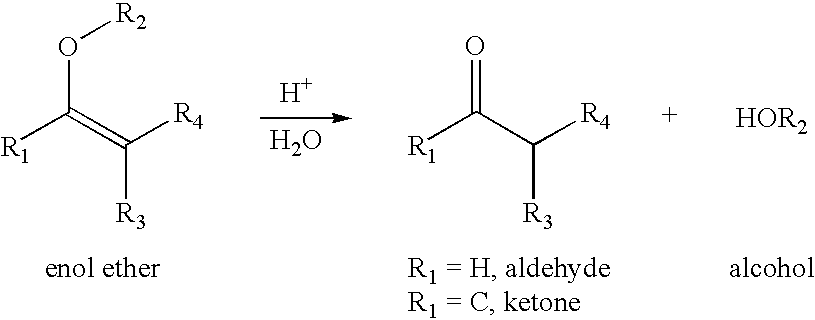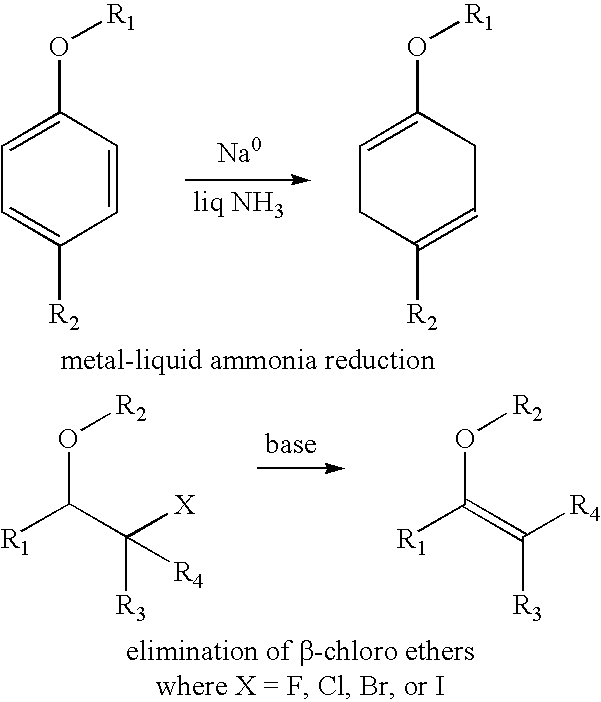Compositions and methods for drug delivery using pH sensitive molecules
a technology of ph sensitive molecules and compositions, applied in the direction of peptides, peptide/protein ingredients, peptide sources, etc., can solve the problems of inability to infect all cell types very efficiently, inactivation of the specific target mrna of the anticancer drug, and toxic anticancer drugs
- Summary
- Abstract
- Description
- Claims
- Application Information
AI Technical Summary
Problems solved by technology
Method used
Image
Examples
example 1
Synthesis and Characterization of Labile Compounds
[0300]A) Synthesis of 2-propionic-3-methylmaleic anhydride (carboxydimethylmaleic anhydride or C-DM): To a suspension of sodium hydride (0.58 g, 25 mmol) in 50 mL anhydrous tetrahydrofuran was added triethyl-2-phosphonopropionate (7.1 g, 30 mmol). After bubbling of hydrogen gas stopped, dimethyl-2-oxoglutarate (3.5 g, 20 mmol) in 10 mL anhydrous tetrahydrofuran was added and stirred for 30 minutes. Water, 10 mL, was then added and the tetrahydrofuran was removed by rotary evaporation. The resulting solid and water mixture was extracted with 3×50 mL ethyl ether. The ether extractions were combined, dried with magnesium sulfate, and concentrated to a light yellow oil. The oil was purified by silica gel chromatography elution with 2:1 ether:hexane to yield 4 gm (82% yield) of pure triester. The 2-propionic-3-methylmaleic anhydride then formed by dissolving of this triester into 50 mL of a 50 / 50 mixture of water and ethanol containing 4....
example 2
Transfection with pH-Sensitive Compounds and / or Membrane Active Agents
[0368]A) In Vitro Transfection with DNA-PLL-KL3 and dimethylmaleamic KL3: To a complex of plasmid DNA pCIluc (10 μg / mL, 0.075 mM in phosphate, 2.6 μg / μL pCIluc; prepared according to Danko, I., Williams, P., Herweijer, H. Zhang, G., Latendresse, J. S., Bock, I., Wolff, J. A. Hum. Mol. Genetics 1997, 6, 1435.) and poly-L-lysine (40 μg / mL) in 0.5 mL of 5 mM HEPES pH 7.5 was added succinylated poly-L-lysine (34,000 MW, Aldrich Chemical), 2,3-dimethylmaleamic melittin and 2,3-dimethylmaleamic KL3. The DNA-poly-L-lysine-2,3-dimethylmaleamic peptide complexes were then added (200 μL) to wells containing 3T3 mouse embryonic fibroblast cells in 290 mM glucose and 5 mM HEPES buffer pH 7.5. After 1.5 h, the glucose media was replaced with Dubelco's modified Eagle Media and the cells were allowed to incubate for 48 h. The cells were then harvested and then assayed for luciferase expression as previously reported (Wolff, J. A...
example 3
Synthesis of Peptides and Polyions
[0435]A) Peptide synthesis. Peptide syntheses were performed using standard solid phase peptide techniques using FMOC chemistry. N-terminal acryloyl 6-aminohexanoyl-SEQ ID NO: 10-CO2 (AcKL3) was synthesized according to published procedure (O'Brien-Simpson, N. M., Ede, N. J., Brown, L. E., Swan, J., Jackson, D. C J. Am. Chem. Soc. 1997, 119, 1183).
[0436]B) Coupling KL3 to poly(allylamine). To a solution of poly(allylamine) (2 mg) in water (0.2 mL) was added KL3 (0.2 mg, 2.5 eq) and 1-(3-dimethylaminopropyl)-3-ethylcarbodiimide hydrochloride (1 mg, 150 eq). The reaction was allowed to react for 16 h and then the mixture was placed into dialysis tubing and dialyzed against 3×1 L for 48 h. The solution was then concentrated by lyophilization to 0.2 mL.
[0437]C) Synthesis of L-cystine-1,4-bis(3-aminopropyl)piperazine copolymer. To a solution of N,N′-Bis(t-BOC)-L-cystine (85 mg, 0.15 mmol) in ethyl acetate (20 mL) was added N,N′-dicyclohexylcarbodiimide (...
PUM
| Property | Measurement | Unit |
|---|---|---|
| Volume | aaaaa | aaaaa |
| Volume | aaaaa | aaaaa |
| Volume | aaaaa | aaaaa |
Abstract
Description
Claims
Application Information
 Login to View More
Login to View More - R&D
- Intellectual Property
- Life Sciences
- Materials
- Tech Scout
- Unparalleled Data Quality
- Higher Quality Content
- 60% Fewer Hallucinations
Browse by: Latest US Patents, China's latest patents, Technical Efficacy Thesaurus, Application Domain, Technology Topic, Popular Technical Reports.
© 2025 PatSnap. All rights reserved.Legal|Privacy policy|Modern Slavery Act Transparency Statement|Sitemap|About US| Contact US: help@patsnap.com



